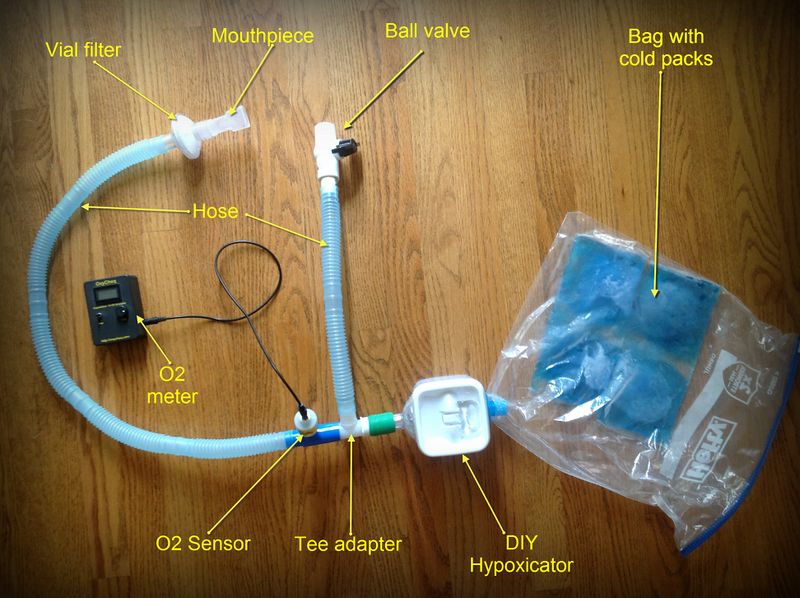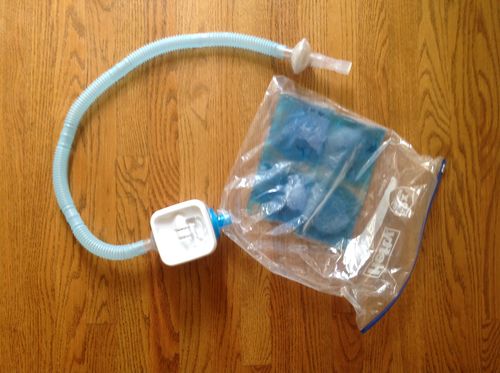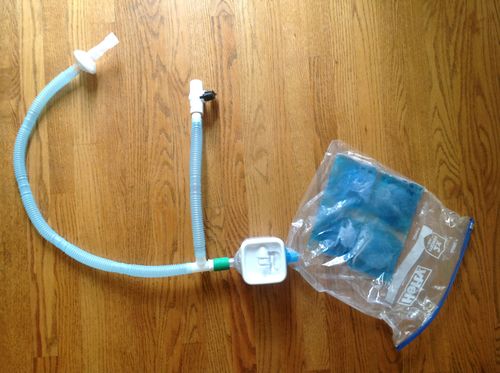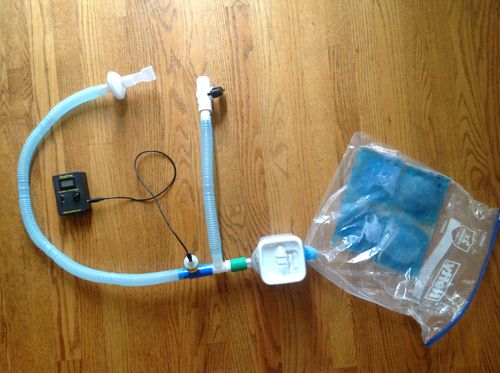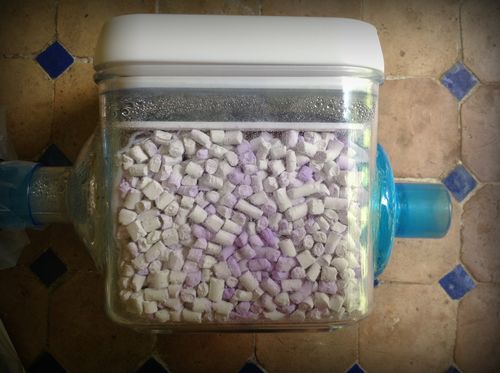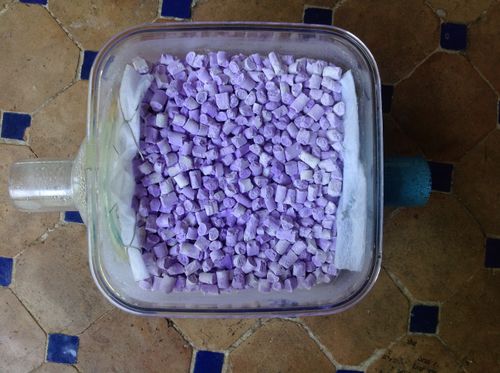DIY Altitude Training
Altitude Training is an effective way of improving performance or preparing for a visit to high elevation. However, many of the solutions are expensive, often running to the thousands of dollars. I've used the AltoLab system for some time, and while it works well, there are some obvious improvements that can be made, plus it's remarkably expensive for what it is. I've created a simple DIY altitude training system that is cheap, effective and does not require any significant fabrication tools or experience.
Contents
1 How does it work?
At high altitude there is the same percentage of oxygen in the air, but the air is under lower pressure, so each lungful contains less oxygen. This causes a drop in the level of oxygen in your blood (called SpO2). Nearly all altitude training systems work by reducing the amount of oxygen in the air you breathe (hypoxia), rather than reducing the pressure (hypobaric). There are various ways of achieving this reduction in oxygen, but the simplest is to rebreathe your exhaled air. This works because you absorb oxygen from the air you breathe. Each time you rebreathe the same air the oxygen level drops. However, there is a problem with simply rebreathing the same air as the carbon dioxide levels rise as the oxygen level drops. Because your breathing rate is driven by the CO2 level in your blood, this will cause you to increase your breathing, which in turn will prevent any drop in your blood oxygen level. The solution is to breathe in and out via a chemical that will remove the CO2, called a CO2 scrubber. This is the function of the DIY Hypoxicator, which is at the heart of this DIY system.
2 Types of Altitude Training
Main article: Altitude Training Approaches
This altitude training system uses Intermittent Hypoxic Exposure (IHE), which uses repeated short periods of low oxygen (hypoxia) rather than a single overnight period that you would get with an 'altitude tent'. With IHE the hypoxia exposure is at rest rather than while exercising. Intermittent Hypoxia while exercising is called Intermittent Hypoxic Training (IHT), though the terminology is used inconsistently. This system could be used for IHT, but I've not tried that.
3 What you will need
You will need to get the following components.
- Hypoxicator. You will need to build a hypoxicator, which is detailed under DIY Hypoxicator. This is the only bit of fabrication you'll need to do. This should only cost around $20 or so to build.
- CO2 Scrubber. As detailed in the DIY Hypoxicator instructions, the CO2 scrubber is a consumable, so buy enough to last you for a few weeks. I typically buy 3-5 bags at a time.
- Pulse Oximeter. To monitor and control your altitude training, and to keep you safe, you need to measure your SpO2 with a Pulse Oximeter. You can get a good one for about $35, or one with a PC interface for recording and analysis with the Hypoxic Timer software for $85.
- Viral/bacterial filters. These will keep your lungs clean and should be replaced periodically. I have 2-3 open that I cycle through to make sure they have plenty of time to dry out between uses. They cost around $3 each; Main Flow Bacterial/Viral Filter at Allegro Medical or Breathing Filter.
- Hose. The hose I use is cheap, though you have to buy it in 100 foot (30m) lengths for $15. CORR-A-FLEX II Roll Tubing at Allegro Medical.
- Mouthpiece. I've not been able to find another supplier of the mouthpiece I use, but this Angled Mouthpiece for MABIS Nebulizers works and it is only $3. (You'll need to tape the hole at the bend.) I recommend against using a facemask, and it's vital you don't attach the mouthpiece to your head. If your SpO2 drops too low you might pass out, in which case you need the mouthpiece to fall out so you'll start breathing normal air and recover.
- Tee adapter. To branch the hose I use a Tee adapter taken from this Drainage Bag as it was only $2.
- Adapters. It's handy to have some adapters like this multi adapt to connect hoses together or change a male to female end, and they are only a dollar or so.
- Ball valve. I got a plastic plumbing ball valve from a local DIY store. It's far from ideal as it is too tight to turn, but it only cost a couple of dollars.
- Bag. I use a cheap 2.5 gallon Ziploc bag for the rebreathing. I cut a small hole in the end and attach it either directly to the hypoxicator with a cable tie or to half of a viral filter so I can remove it easily.
- Freezer packs (optional). Rebreathing can cause quite a buildup of heat and moisture, so putting a few freezer packs in the bag helps keep things cool and condenses out some of the moisture.
- O2 Meter (optional). I have a OxyCheq Expedition-X Oxygen Analyzer which is expensive at $250, but I find it useful. The O2 level changes faster than SpO2, so it makes adjustments easier. I would not get the meter until you know you'll be using the system regularly enough to justify the cost.
4 Three Configurations
5 Using the System
- Connect all the parts as shown in the pictures above.
- Put on the pulse Oximeter and wait for it to get a reading.
- If you're using the ball valve, close it completely.
- Start a timer (or use the Hypoxic Timer software).
- Start breathing through the mouthpiece. It will take a minute or two for the oxygen in the bag to drop, and your SpO2 drop will lag behind that.
- Once your SpO2 drops, but before it reaches your target you will need to start mixing some room air into the system. You can either do this by cracking open the ball valve slightly or by taking a partial breath from the room. You will need to find the right balance of room air to rebreathed air that will keep your SpO2 near your target based on trial and error. This is takes some practice to get right, but it a lot easier with the ball valve.
- Once your time is up, remove the mouthpiece and breathe room air. After the recovery period, restart the hypoxia and repeat the appropriate number of intervals.
- Some guidance on IHE plans can be found at Intermittent Hypoxic Exposure.
6 After Use
After you've finished using the system, disconnect the parts to let them dry out. However, the hypoxicator should not be dried out as moisture is part of the CO2 scrubber.
7 CO2 Scrubber Replacement
Because the CO2 scrubber uses a chemical reaction to remove the CO2, it will become exhausted over time. I've found that the scrubber seems to last much longer in my DIY system than the AltoLab system I used before. The best indication that the scrubber is exhausted is that you will feel a change in your lungs. This feeling is due to the buildup of CO2, which creates a strong desire to breathe, and you will feel like you can't get enough air. If you have that feeling, it's time to replace the CO2 scrubber. The scrubber has a color change indicator that will go purple, which you can see if you use a clear sided container. The color will change even on the first use, but it will fade after a few hours. I've found that once the color change is still present next time I come to use the system it's probably close to exhaustion.
8 Troubleshooting
There are a few common problems you may encounter with this DIY system.
- If your SpO2 level does not drop and your breathing is relaxed and easy, you probably have a leak somewhere.
- If your SpO2 level does not drop, your breathing is strained and you feel like your lungs are burning, then your CO2 scrubber is not working. If the scrubber has turned purple, then it's exhausted, but if it's still white then maybe your DIY Hypoxicator is too small.
- If your CO2 scrubber seems to get exhausted quickly, check that you are filling it fully. See the image below for details.

9 Iron Deficiency and Anemia
If you are deficient in iron then it will be difficult for your body to adapt to altitude training. The best thing is to get your iron levels checked with a serum ferritin blood test. I have mine tested periodically at a local Walk In Lab. The cost is about $40, though they sometimes run offers.
10 Feedback requested
If you build one of these systems, I'd be grateful if you let me know how you get on. I'm also interested if you find any improved parts or other suggestions for improvements.
